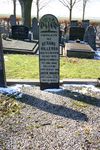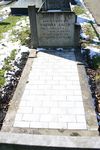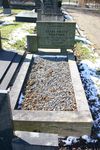Dutch War Graves Nieuw Beerta
At the Municipal Cemetery in Nieuw Beerta are 3 Dutch war graves.
The names of the victims:
Eltjo Pieter Hillenga, farmhand
born 12.8.1918 in Beerta, deceased 27.8.1944 at Emden (D)
Gerard Hillenga, farmhand
born 30.5.1915 in Beerta, deceased 27.8.1944 at Emden (D)
Harmina Aaltje Speelman
born 5.9.1929, deceased 21.5.1943
(on her way to school, she was killed by plane bullets.)
NSB Grave
The NSB grave of the Ebels family is located at the Municipal Cemetery in Nieuw Beerta. In the grave lie the bodies of:
Everhard Tonko Ebels, born May 3, 1906 in Beerta
Tetje Tjadduwe Henderika Ebels - Dijkstra, born 17 June 1908 in Midwolda
and their children:
Auwina Eppien Ebels, born April 14, 1931 in Beerta
Fekke Ebel Hajo Ebels, born June 4, 1933 in Beerta
Derk Doeko Ebels, born June 7, 1938 in Beerta
There are many stories about the cause of death of the Ebels family.
From my own research I was able to determine the correct cause.
On November 9, 1981, Dr. L.de Jong a letter to B&W van Finsterwolde.
In part 10b of my work "The Kingdom of the Netherlands in the Second World War" I pay attention to the liberation of the province of Groningen, among others, and I mention in that context the data known to me about the arrest of "wrong" elements. In that context I came across a note in the published letter from a former NSB member to his granddaughter, written in the year 1966 or 1967.
The relevant passage reads:
"They are all dead, so I can tell you the names now. On our way to a hiding place we spent a day in his house. Ebels was a wealthy Groningen farmer from Finsterwolde, as far as I know nephew of the Commissioner of the Queen in the Province of Groningen.
It was this way on his farm at the liberation. The farm was surrounded and set on fire by the so-called Domestic Forces, Supreme Commander Prince Bernhard (of course he didn't know what a mess it was). When the smoke and flames forced residents to come out, they were shot at, given the choice between being burned inside or killed outside. Husband, wife, and four or so young children have perished."
I have not found anything about this happening elsewhere. If it happened I should mention it in my text, but it may be that the letter writer has given an account which was grossly exaggerated in its content.
I would be very grateful if I could receive further information through your mediation. In addition, I would like to inform you that, as my other data show, excesses have come about in numerous places when picking up "wrong" elements.
On March 19, 1982, the Board of B&W writes back:
In response to your above-mentioned letter, we inform you that this concerns the Ebels family, at the time living in the municipality of Beerta, at the address Kroonpolder A 425.
The Germans had set up anti-aircraft guns to protect the port city of Emden on the other side of the Dollard, both at Fiemel (municipality of Termunten) and on the dike of the Carel Coenraadpolder in the municipality of Finsterwolde.
During the liberation days, shots were also fired at the liberators from these places. A Polish tank near Ebels' farm was also fired upon. This tank ended up in a ditch and became unusable.
The four Poles came out of the tank and then, presumably, shots were fired at them from the farm or the surrounding rapeseed field. Partly because they knew and had sounded out that there was a transmitter of the Germans in the farm, they ignited in anger and then ordered the Ebels family, who was already in the village of Drieborg to wait for removal, to return to the farm .
Once there, the family was placed against the farmhouse and were shot and then thrown into the farmhouse, which was then set on fire (shot).
Incidentally, it is noted that the transmitter in question, which maintained contacts with the aforementioned anti-aircraft guns, had been placed in Ebels' farm by the retreating Germans just 24 hours earlier.
The incident took place on April 17, 1945.
It is also noted that the family was known to be sympathetic to the N.S.B.
N.B. The above is based on the reading of a well-known Drieborger, who is known to have been well informed. It should be noted that in the vernacular also other stories are doing the rounds.
According to the letter from B & W of the municipality of Beerta.
A new book about this monument and its further history was published in 2020 by Gerard Olinga, a former detective, who lists all known facts as a former police officer and discusses all options. This book also discusses three NSB evacuees who were on the farm and are still missing. The story that the Poles are behind this massacre is completely debunked. The then town clerk was also the BS commander at that time and put the arrest, which probably got out of hand, on the Polish unit, which had already moved on and was therefore an easy scapegoat.
Do you have more information about this location? Inform us!
Source
- Text: Bert Deelman
- Photos: Bert Deelman
- Oorlogsgraven Stichting
- NIOD
- Nieuwe Statenzijl in de Tweede Wereldoorlog
Nearby
Monument
- War Memorial Nieuw Beerta - Nieuw Beerta
- Commemorative column "Route of the Persecution" - Bad Nieuweschans
- Memorial "The Last Glance" - Bad Nieuweschans
Cemetery
- War Grave Serbian Prisoner-of-War - Nieuw Beerta
- Dutch War Graves Municipal Cemetery Bad Nieuweschans - Bad Nieuweschans
- Commonwealth War Graves Bad Municipal Cemetery Nieuweschans - Bad Nieuweschans
Remembrance Stone
- Stumbling Stone Molenlaan 14 - Nieuw Beerta
- Stumbling Stone Oudeweg 3 - Drieborg
- Stumbling Stone Drieborg 36 - Drieborg






